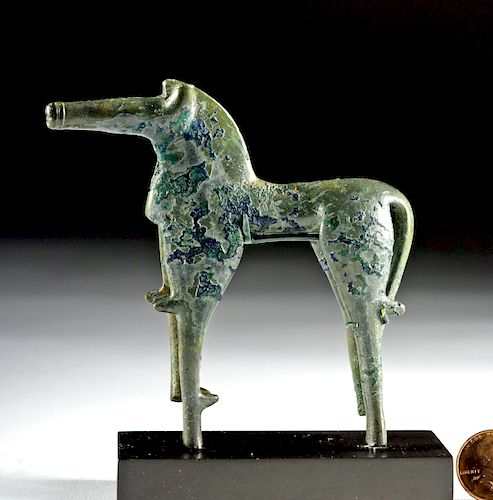Important Greek Geometric Bronze Horse
Lot 19b
About Seller
Artemis Fine Arts
686 S Taylor Ave, Ste 106
Louisville, CO 80027
United States
Selling antiquities, ancient and ethnographic art online since 1993, Artemis Gallery specializes in Classical Antiquities (Egyptian, Greek, Roman, Near Eastern), Asian, Pre-Columbian, African / Tribal / Oceanographic art. Our extensive inventory includes pottery, stone, metal, wood, glass and textil...Read more
Estimate:
$25,000 - $35,000
Absentee vs Live bid
Two ways to bid:
- Leave a max absentee bid and the platform will bid on your behalf up to your maximum bid during the live auction.
- Bid live during the auction and your bids will be submitted real-time to the auctioneer.
Bid Increments
| Price | Bid Increment |
|---|---|
| $0 | $25 |
| $300 | $50 |
| $1,000 | $100 |
| $2,000 | $250 |
| $5,000 | $500 |
| $10,000 | $1,000 |
| $20,000 | $2,500 |
| $50,000 | $5,000 |
| $100,000 | $10,000 |
| $200,000 | $20,000 |
About Auction
By Artemis Fine Arts
Feb 21, 2019
Set Reminder
2019-02-21 10:00:00
2019-02-21 10:00:00
America/New_York
Bidsquare
Bidsquare : Exceptional Antiquities, Asian, Ethnographic
https://www.bidsquare.com/auctions/artemis-gallery/exceptional-antiquities-asian-ethnographic-3858
An important one-day auction featuring museum-worthy examples of Egyptian, Greek, Roman, Etruscan, Near Eastern, Far East / Asian, Pre-Columbian, African / Tribal, Oceanic, Native American, Spanish Colonial, Russian, Fossils, Ancient Jewelry, Fine Art, so much more! Artemis Fine Arts info@artemisgallery.com
An important one-day auction featuring museum-worthy examples of Egyptian, Greek, Roman, Etruscan, Near Eastern, Far East / Asian, Pre-Columbian, African / Tribal, Oceanic, Native American, Spanish Colonial, Russian, Fossils, Ancient Jewelry, Fine Art, so much more! Artemis Fine Arts info@artemisgallery.com
- Lot Description
Ancient Greece, possibly Laconian Type, Geometric Period, ca. 8th century BCE. A petite bronze horse presenting the characteristic abstract stylings of the Geometric period. The equine form stands with an elongated body upon a pair of slender legs, with a sinuous tail and an angular posterior comprising the back end. The minimalist head exhibits a stylized integral crested mane, a drawn-out face with cylindrical muzzle, and singular perky ear on top, with a smooth layer of sage-hued patina and areas of deeper forest green patina covering the surface. Zoomorphic representations of this period are generally small in scale, and the figures have simplified schematic shapes as we see in this example. A wonderful piece indicative of the beginning of Greek figural art when the Hellenistic penchant for naturalism was in its embryonic stages. Size: 3.75" L x 3.75" H (9.5 cm x 9.5 cm); 4.25" H (10.8 cm) on included custom stand.
The Geometric Period was when many of the trends that would define Classical Greece began: there was an explosion in population leading to the development of proto-urban centers and the construction of monumental temples and sanctuaries; writing, lost after the Mycenaean period, returned to Greece, and along with it came the writing down of The Iliad and The Odyssey for the first time; finally, much of the artwork of the period depicts scenes of gods that would later become codified as the official Greek state religion. As would be expected in a time period that in retrospect seems obsessed with epic themes, horses, chariots, and warriors were the most commonly depicted things in Geometric Period art.
A similar Greek Geometric Period bronze horse sold for $842,500 at Sotheby's New York, 07 December 2010, Lot 3. (http://www.sothebys.com/en/auctions/ecatalogue/2010/antiquities-from-the-collection-of-the-late-clarence-day-n08723/lot.3.html)
Cf: J.L. Zimmermann, Les Chevaux de Bronze Dans l'Art Geometrique Grec (1989) 33.114. For a similar example in The Metropolitan Museum of Art, New York (inv. no. 21.88.24) see Zimmermann, op. cit., p. 180, no. 27, pl. 42. See another similar "Laconian" example in "Glories of the Past: Ancient Art from the Shelby White and Leon Levy Collection", Metropolitan Museum of Art, 1990, no. 72.
Provenance: private East Coast, USA collection acquired at Gorny & Mosch, Munich, Germany, Auction 252, December 12, 2017, Lot 282; ex-Sammlung O.S., Nordrhein-Westfalen, 1979
All items legal to buy/sell under U.S. Statute covering cultural patrimony Code 2600, CHAPTER 14, and are guaranteed to be as described or your money back.
A Certificate of Authenticity will accompany all winning bids.
We ship worldwide and handle all shipping in-house for your convenience.
#141436Missing one ear. Losses from tip of other ear, lower sections of legs and tail. Incredible patina of sage green and aqua hues.Condition
- Shipping Info
-
All shipping is handled in-house for your convenience. Your invoice from Artemis Gallery will include shipping calculation instructions. If in doubt, please inquire BEFORE bidding for estimated shipping costs for individual items.
-
- Buyer's Premium



 EUR
EUR CAD
CAD AUD
AUD GBP
GBP MXN
MXN HKD
HKD CNY
CNY MYR
MYR SEK
SEK SGD
SGD CHF
CHF THB
THB














